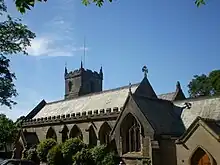Chorley
Chorley is a town and the administrative centre of the wider Borough of Chorley in Lancashire, England,[1] 8 miles (13 km) north of Wigan, 11 miles (18 km) south west of Blackburn, 11 miles (18 km) north west of Bolton, 12 miles (19 km) south of Preston and 20 miles (32 km) north west of Manchester. The town's wealth came principally from the cotton industry.
| Chorley | |
|---|---|
| Town | |
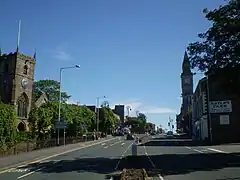 Entering Chorley town centre | |
 Chorley Shown within Chorley Borough  Chorley Location within Lancashire | |
| Population | 36,682 (2020) |
| Demonym | Chorlean |
| OS grid reference | SD5817 |
| District | |
| Shire county | |
| Region | |
| Country | England |
| Sovereign state | United Kingdom |
| Post town | CHORLEY |
| Postcode district | PR6, PR7 |
| Dialling code | 01257 |
| Police | Lancashire |
| Fire | Lancashire |
| Ambulance | North West |
| UK Parliament | |
In the 1970s, the skyline was dominated by factory chimneys, but most have now been demolished: remnants of the industrial past include Morrisons chimney and other mill buildings, and the streets of terraced houses for mill workers. Chorley is the home of the Chorley cake.[2][3]
History
Toponymy
The name Chorley comes from two Anglo-Saxon words, ċeorl and lēah, probably meaning "the peasants' clearing".[4] Ley (also lēah or leigh) is a common element of place-name, meaning a clearing in a woodland; ċeorl refers to a person of status similar to a freeman or a yeoman.
Prehistory
There was no known occupation in Chorley until the Middle Ages, though archaeological evidence has shown that the area around the town has been inhabited since at least the Bronze Age.[5] There are various remains of prehistoric occupation on the nearby Anglezarke Moor, including the Round Loaf tumulus which is believed to date from 3500 BC.[6]
A pottery burial urn from this period was discovered in 1963 on land next to Astley Hall Farm and later excavation in the 1970s revealed another burial urn and four cremation pits dating from the Bronze Age.[7]
Roman period
During the Roman era a Roman road ran near Chorley between Wigan and Walton-le-Dale.[5] Hoards dating from the Roman period have also been found nearby at Whittle-le-Woods and Heapey.[5]
Medieval period
Chorley was not listed in the Domesday Book of 1086, though it is thought to be one of the twelve berewicks in the Leyland Hundred.[8]
Chorley first appears in historical records in the mid thirteenth century as part of the portion of the Croston Lordship acquired by William de Ferrers, Earl of Derby, around 1250.[9] The Earl established Chorley as a small borough comprising a two-row settlement arranged along what later became Market Street.[5] It appears that the borough was short lived, as it does not appear in a report of a commission on the Leyland Hundred in 1341.[10] It is most likely that the borough was sacked by the Scots during the Great Raid of 1322, with Chorley being one of the southernmost points reached in Northern England. This led to the construction of a Peel tower, which said to have been located somewhere close to Duxbury Hall.
The manorial history of Chorley is complex as the manor had no single lord throughout most of this period, as it had been split into moieties and was managed by several different families.[9] This led to Chorley having several manorial halls, which in this period included Chorley Hall, built in the 14th century by the de Chorley family, which has since the 19th or 20th century been demolished. Very little is known of Chorley Hall, although according to what the painter John Bird painted in 1795, its location to where it once stood is said to have been where The Parish of St Laurence Church of England Primary School now stands, with phantom steps near to the school within Astley Park being the only physical clue to the hall's existence. There is also Lower Chorley Hall, which was owned by the Gillibrand family from 1583 (later rebuilt in the 19th century as Gillibrand Hall).[9][11] It is believed the borough of Chorley was not a success in this period because of the lack of manorial leadership and the dispersed nature of the small population.[11] St Laurence's Church is the oldest remaining building in Chorley and first appears in historical records when it was dedicated in 1362, though it is believed there was already an earlier Anglo-Saxon chapel on the site which was a daughter foundation of Croston Parish Church.[9][11] It is believed that the church is named after Saint Laurence, an Irish saint who died in Normandy in the 12th century, whose bones were conveyed to the church by local noble Sir Rowland Standish[12] Duxbury,[13] an ancestor of Myles Standish (an English military officer hired by the Pilgrims as military adviser for their Plymouth expedition to the New World).
As happened in many other instances following the Dissolution of the Monasteries, these relics went missing in the turmoil of the English Reformation under the rule of Henry VIII.[14]
Chorley was granted a market charter by Henry VII in 1498 and have since held it every Tuesday. Before the reformation, it would coincide with a fair that was held annually on the feast of St Lawrence.[10]
19th century to present
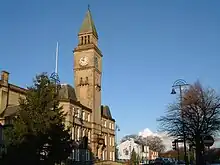
Chorley, like most Lancashire towns, gained its wealth from the Industrial Revolution of the 19th century which was also responsible for the town's growth. Chorley was a vital cotton town with many mills littering the skyline up to the late twentieth century. Most mills were demolished between the 1950s and 2000s with those remaining converted for modern business purposes. Today only a minority remain in use for actual manufacturing, and the last mill to stop producing textiles was Lawrence's in 2009.[15]
Also, given its location on the edge of Lancashire Coalfield, Chorley was vital in coal mining. Several pits existed in Duxbury Woods, the Gillibrand area and more numerously in Coppull. Chisnall Hall Colliery at Coppull was considered the biggest Lancashire pit outside of Wigan and one of many located in the Chorley suburb. The last pit in the area to close was the Ellerbeck Colliery in 1987 which was located south of Chorley, between Coppull and Adlington.
The town played an important role during the Second World War, when it was home to the Royal Ordnance Factory, a large munitions manufacturer in the village of Euxton about 2 miles (3 km) from the town centre. A smaller factory was also built near the railway line of Blackburn–Wigan in Heapey.
Religion

The Church of England parish church of St Laurence, located on Union Street, has been a place of Christian worship for over 800 years.[16] The Church of England parish church of St George, situated on St George's Street, is an important example of the work of architect Thomas Rickman, a major figure in the Gothic Revival. It was built as a Commissioners' church in 1822.[17]
St Mary's Roman Catholic Church is based in the town centre at Mount Pleasant. The parish was founded in 1847, in a chapel in Chapel Street. The land for the church was purchased in 1851 and the first building erected in 1853. It was opened in June 1853. The church can sit 750 persons. Pugin & Pugin of London and Hansom are the architects.[18]
Chorley United Reformed Church[19] is one of the oldest and largest United Reformed Churches in the north west. Founded in 1792 as an Independent Church it later affiliated to the Congregational church and in 1972 voted to become part of the new United Reformed Church (URC). The church is home to the oldest Scout Troop in the town, established in 1919.[20] In January 2017 it was announced that the church building, which had been at its current site since 1792, would be demolished, and the congregation relocated to other premises.[21] These plans never came to fruition and the church building was instead refurbished in 2020.[22]
The church has a Junior Church together with Beavers, Cubs, Scouts, Rainbows, Brownies and Guides. During 2012, the church became the first church to advertise from the air when a very large cross was painted on the church car park.
In the north of the town, there is a park containing a meeting house and a temple of the Church of Jesus Christ of Latter-day Saints (LDS Church). The temple, which is regarded as a local landmark,[23] is the largest LDS temple in Europe[24] and named the Preston England Temple.[25] Construction on the temple commenced in 1994 and was completed in 1998. Connected to the temple campus is the England Missionary Training Centre for the LDS Church which houses church representatives preparing to fill proselytizing and service assignments in Great Britain and other parts of Europe.[26]
Chorley's only mosque[27] is to be found on the corner of Brooke Street and Charnock Street. The building officially opened in March 2006, having been in planning for over three years.[28][29]
Governance

In 1837, Chorley joined with other townships (or civil parishes) in the area to become head of the Chorley Poor Law Union, which took responsibility for the administration and funding of the Poor Law in the area.[30] Chorley became incorporated as a municipal borough in 1881; it was governed by a mayor, a council of eight aldermen and twenty four councillors.[31]
The population of the Municipal Borough of Chorley remained roughly static in the 20th century, with the 1911 census showing 30,315 people and the 1971 census showing 31,665. Under the Local Government Act 1972, Chorley became the core of a larger non-metropolitan district on 1 April 1974. The present Borough of Chorley has forty-two councillors, representing 14 three-member electoral wards in Chorley town council.
The Member of Parliament for the constituency of Chorley, since 1997, is Lindsay Hoyle, Speaker of the House of Commons. He was formerly a Labour MP.[32]
Geography
The principal river in the town is the Yarrow. The Black Brook is a tributary of the Yarrow. The name of the River Chor was back-formed from Chorley and runs not far from the centre of the town, notably through Astley Park. Chorley is located at the foot of the West Pennine Moors and is overlooked by Healey Nab, a small hill which is part of the West Pennine Moors. It is the seat for the Borough of Chorley, which is made up of Chorley and its surrounding villages.
Chorley had a population of 33,424 at the 2001 census, with the wider borough of Chorley having a population of 101,991. Chorley forms a conurbation with Preston and Leyland and was once proposed as being designated part of the Central Lancashire New Town under the New Towns Act,[33] a proposal which was eventually scaled back.[34]
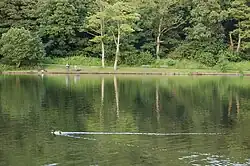
Economy
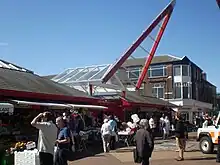
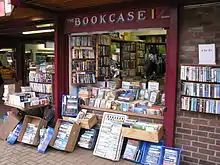
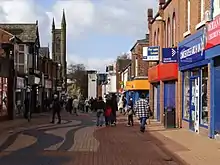
The first signs of industry, as with many towns in Lancashire, was mining; evidence of which can be seen by the various abandoned quarries on the outskirts of the town. One of these is Anglezarke Quarry, between Chorley and Horwich. Remnants of mining include an old railway bridge from the Duxbury Mine off Wigan Lane. Eventually, the mining industry was replaced by cotton mills.
Manufacture of trucks was inherited from the neighbouring town of Leyland. A large factory on Pilling Lane produced, including military vehicles and tanks during the Second World War.
After the Second World War, production was reduced and the final part of the site was closed in 2008 by BAE Systems.[35] A large part of the site has been redeveloped for residential and industrial use as Buckshaw Village. Through the twentieth century, especially the latter half, Chorley suffered the loss of much of its manufacturing capacity with great losses in or the completely disappearance of its coal, textiles, motor vehicles and armaments industries.
Leyland Trucks and BAE Systems are Central Lancashire's largest employers, with their sites in Leyland and Samlesbury respectively.
Other companies with a presence in the borough are:
- Telent
- FedEx's North West depot is located in the town
- DXC Technology has two locations: one in Euxton and the other in Clayton-le-Woods, north of Chorley
- Multipart Solutions Limited, successor to the parts arm of the Leyland DAF
- Porter Lancastrian is a manufacturer of beer pumps, under the Porta brand
In 2011, Chorley Council launched an initiative, Choose Chorley, to encourage SMEs and large businesses to relocate to Chorley. The initiative offers red carpet introductions to key people in the town, financial incentives and tailored support for business growth.[36]

The town is the home of the Chorley cake. Every October, the Chorley Cake Street Fair promotes the cakes, with a competition for local bakers to produce the largest ever Chorley cake; the event restarted in 1995.[37]
Healthcare
Chorley is served by the local NHS hospital Chorley and South Ribble Hospital which is located on Euxton Lane, in addition to a private hospital located in Euxton. The town also had another major hospital formerly on Eaves Lane, before this closed in the 1990s. There was also the Heath Charnock isolation hospital on Hut Lane which dealt with infectious diseases before reverting to use for long term patients, before closing in the 1990s.
Transport
Road
Chorley town centre is bisected by the A6 Roman road. It is located near to junctions 6 and 8 of the M61 motorway and junction 27 of the M6; Charnock Richard services are sited within the borough.
Buses

The town's bus station, Chorley Interchange, opened in February 2003, replacing an older building. Services are provided by several operators:[38]
- Stagecoach Merseyside and South Lancashire operates routes that connect the town with Bolton, Blackburn, Leyland, Preston, Southport and Ormskirk
- During the summer, Stagecoach also operates the X8 to Keswick via Preston, Lancaster and Windermere
- Blackburn Bus Company operates a route to Blackburn
- Tyrers Coaches operate buses to Preston and surrounding areas
- Preston Bus operates buses to Leyland
- Arriva North West operates services to Wigan
Railway
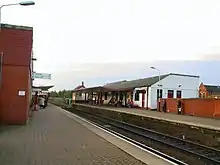
Chorley railway station is served by Northern, which operates routes on the Manchester to Preston Line; direct destinations include Bolton, Preston, Barrow, Blackpool, Manchester Piccadilly and Manchester Airport.[39]
TransPennine Express services, which operate from Manchester Airport to Glasgow or Edinburgh, pass through the station but do not stop.[40]
The station was also served by the Wigan-Blackburn line, until it was closed in 1960; the line also had stops at Heapey, Brinscall, Withnell and White Bear (Adlington).
Elsewhere in the borough, there are railway stations at Euxton, on the Preston - Wigan line; at Adlington and Buckshaw Village, on the Manchester–Preston line; and at Croston, on the Ormskirk Branch Line.
Waterways

The Leeds and Liverpool Canal runs parallel to Chorley; several marinas and locks are located in the area, including:
- White Bear Marina, Adlington
- Cowling Launch, Chorley
- Top Lock, Whittle
- Botany Brow
- Botany Bay Boatyard
- Riley Green, Hoghton
Education
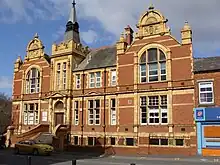
Chorley is home to numerous primary schools, both council and church supported. The town has the following six high schools:
- Holy Cross Catholic High School
- Albany Academy
- Bishop Rawstorne CE Academy
- Parklands High School
- Southlands High School
- St. Michael's CE High School
Some independent schools are also present just outside the borough. Most Chorley children go on to attend the nearby Runshaw College in Leyland. Runshaw College has also expanded into the former administration site of ROF Chorley and is using, amongst others, the main administration building.
Lancashire College, based in Chorley, is a part of Lancashire County Council's Lancashire Adult Learning, offering a wide range of courses, a speciality being intensive residential language courses. From 1905 to 1981, the town was home to Chorley Training College (from the 1960s known as Chorley 'Day' Training College), designed by the Victorian and Edwardian architect Henry Cheers, and the town centre building now occupying this site is now Chorley Public Library.[41]
Sport
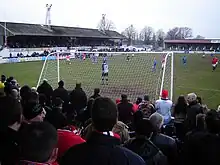
Chorley is home to the semi professional football team, Chorley F.C., known as the Magpies due to their black and white strip. Founded as a rugby team in 1875, they switched to playing football eight years later. Since then they have had limited success, with their most memorable moments being two appearances in the second round of the FA Cup and two seasons in the Football Conference in the late 1980s. They played in the National League in the 2019/20 season having won promotion from the National League North in the previous season, but were relegated back to the National League North. The team gained fame after qualifying for the 4th round of the 2020-21 season of the FA Cup.
The town and surrounding boroughs boast a number of cricket clubs, with two teams taking the town's name. Chorley Cricket Club currently play in the Northern League and were finalists in the ECB National Club Cricket Championship for three consecutive seasons from 1994 to 1996, winning the trophy on the first two occasions. Chorley St James Cricket Club are the second side in the town, competing in the Southport & District Amateur Cricket League, having been members of the Chorley League until its demise in 2005.
The town is home to the Chorley Buccaneers American Football Club. Founded in the year 2000, the Bucs now have eight competitive teams and over 120 players competing in the BAFA National Leagues structure. They are based at Parklands Academy in Chorley. The club has three National Championship titles to their name in their 17-year existence, most recently in 2016.
Chorley RUFC was founded in the early 1970s and initially their matches were on played on fields at Astley Park. Since there was no club house in the early days the team played from the Prince of Wales pub, near the town's covered market. Work started on a new clubhouse on 22 March 1984 , on an area of land off Chancery Road, situated on the edge of the freshly constructed Astley Village Estate. The club currently run two senior sides and a mini section, the 1st XV playing in the RFU North Lancs 2 division.
Until 2004, Chorley had a rugby league side, Chorley Lynx, who played in League Two of the Rugby League National Leagues. The club was forced to close in 2004, due to small crowds and the withdrawal of funding by backer Trevor Hemmings. Many of the club's players and staff joined nearby Blackpool Panthers. The only rugby league side currently active who are situated in chorley is amateur side chorley panthers
Chorley is home to track cyclists including Olympic gold medal winners Jason Queally and Bradley Wiggins, and Paralympic silver medallist Rik Waddon, due in part to the proximity of the town to the Manchester Velodrome; it is also the home town of Paralympic gold medallist Natalie Jones.
The council owned leisure centre contains a swimming pool, sports hall, squash courts and a small fitness suite. The borough also includes other gym facilities, two other council-owned leisure centres (at Clayton Green and Coppull) and another public swimming pool at Brinscall. The town is also home to a Next Generation fitness centre, other private pools and leisure centres, and a David Lloyd Tennis Centre.

Duxbury Park municipal golf course is 1 mile (2 km) south of Chorley town centre.
The town is home to many amateur football, rugby and cricket teams. There are also several grass football pitches, bowling greens and tennis courts. A public outdoor swimming pool in Astley Park was demolished in the 1990s for health and safety reasons.
Chorley Athletic and Triathlon Club regularly compete in road, cross country, fell, athletics and triathlon events. Chorley Cycling Club was formed in 2011, resurrecting a club which had disbanded around 1953. The club caters to both leisure and racing members and runs regular training and social rides on local roads.[42] Chorley JKS Shotokan Karate Club was established in the town in 2012.
Media
Chorley has two local newspapers: the weekly Chorley Guardian and the free Chorley Citizen. A British comedy television show, Phoenix Nights, cited Chorley's radio station, Chorley FM, whose slogan was "Coming in your ears". The station, based in Chorley, originally broadcast for only a few weeks, but in 2005 received a licence to broadcast from Chorley Community Centre (see Chorley FM).
It is the home of actor Joseph Gilgun, of Brassic, This is England, Misfits and Preacher.
As well as Phoenix Nights, comedian Dave Spikey based his comedy series Dead Man Weds in, and filmed most of it in, Chorley. Steve Pemberton, the creator of The League of Gentlemen, based most of its characters on folk from Adlington.
Places of interest
| Key | |
| Abbey/Priory/Cathedral | |
| Accessible open space | |
| Amusement/Theme Park | |
| Castle | |
| Country Park | |
| English Heritage | |
| Forestry Commission | |
| Heritage railway | |
| Historic House | |
| Places of Worship | |
| Museum (free/not free) | |
| National Trust | |
| Theatre | |
| Zoo | |

- Astley Park and Astley Hall

- Bank Hall

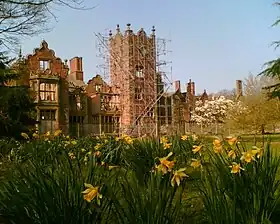 Bank Hall, Bretherton, a Jacobean mansion house, awaiting restoration. Home to Lancashire's oldest Yew tree and one of the two fallen sequoia in the UK. Open on limited open days arranged by the Bank Hall Action Group.
Bank Hall, Bretherton, a Jacobean mansion house, awaiting restoration. Home to Lancashire's oldest Yew tree and one of the two fallen sequoia in the UK. Open on limited open days arranged by the Bank Hall Action Group. - Preston England Temple

- Duxbury Park and Golf Course

- White Coppice & Great Hill

- Heskin Hall

- Healey Nab

- Leeds & Liverpool Canal

- Rivington Pike


- Winter Hill

- Worden Park


- Yarrow Valley Country Park


Notable residents
_-_Sir_Henry_Tate_-_N03517_-_National_Gallery.jpg.webp)
- Loui Batley (born 1987), (actress and dancer)
- Bill Beaumont (born 1952), (former England rugby union captain)
- Walter Berg (born 1947), (astrologer)
- Leonora Carrington (1917–2011), (painter)
- Phil Cool (born 1948), (comedian)
- C. D. Darlington (1903–1981), (biologist)
- Derek Draper (born 1967), (former Labour spin doctor and newspaper columnist)
- Simon Farnworth (born 1963), (footballer, later physiotherapist)
- John Foxx (born 1948), (musician)
- Joseph Gilgun (born 1984), (actor)
- Paul Grayson (born 1971), (England rugby union player)
- Rick Guard (jazz singer and songwriter)
- Sir Walter Haworth (1883–1950), (Nobel Prize winner)
- Trevor Hemmings (1935-2021), (businessman)
- Adam Henley (born 1994), (footballer, formerly of Blackburn Rovers and Real Salt Lake, now playing for Chorley)
- Teddy Hodgson (1885–1919), (from Chorley, played for Burnley F.C., F.A. Cup Winners against Liverpool in 1914)
- Anna Hopkin MBE (born 1996), (swimmer and Olympic gold medallist)
- Lindsay Hoyle (born 1957), (MP)
- Conrad Hunte (1932–1999), (former West Indian Test cricketer, lived in Chorley before the 1957 Test Series against England)
- Charles Lightoller (1874–1952), (highest-ranking crew member to survive the sinking of the RMS Titanic)
- Paul McKenna (born 1977), (footballer)
- Paul Mariner (1953–2021), (England international footballer)
- Rifleman William Mariner VC (1882–1916), soldier awarded the Victoria Cross at Cambrin in 1915.[45]
- Barry Mason (1935–2021), (songwriter)
- Ken Morley (born 1943), (actor)
- Sheila Parker (born 1947), (former captain of the England women's national football team)
- Phil Parkinson (born 1967), (footballer, later football manager)
- Steve Pemberton (born 1967), (actor)
- Adam Nagaitis (born 1985), (actor)
- Jason Queally (born 1970), (cyclist)
- Thomas Rawlinson (18th-century industrialist, believed to have been born in Chorley)
- Kevin Simm (born 1980), (musician of Liberty X and Wet Wet Wet fame, also winner of the fifth season of The Voice UK)
- Tom Smith (born 1985), (cricketer)
- Myles Standish (c. 1584 – 1656), (founder of the Pilgrim Fathers)
- Starsailor (pop group)
- Tom Criddle Stephenson (1893–1987), (journalist and champion of walkers' rights)
- Sir Henry Tate (1819–1899), (sugar magnate and founder of the Tate Gallery, London)
- Josh Charnley (born 1991), (rugby league footballer)
- David Unsworth (born 1973), (Everton footballer, later Everton U-23 manager)
- Mickey Walsh (born 1954), (former Irish international footballer)
- Sir Holburt Jacob Waring Bt CBE FRCS (1866–1953), vice-chancellor of the University of London from 1922 to 1924
- Rosemarie Wright (1931–2020), (pianist)
See also
References
- Chisholm, Hugh, ed. (1911). . Encyclopædia Britannica. Vol. 6 (11th ed.). Cambridge University Press. p. 270.
- Evans, Jacqueline (July 2012). "Lancashire Population, 2011 Census". www.lancashire.gov.uk. Lancashire County Council. Archived from the original on 17 April 2014. Retrieved 4 April 2016.
- The sum of the ward populations 6,823 (Chorley East Archived 4 March 2016 at the Wayback Machine), 6,651 (Chorley North East Archived 6 March 2016 at the Wayback Machine), 5,961 (Chorley North West Archived 6 March 2016 at the Wayback Machine), 6,635 (Chorley South East Archived 6 March 2016 at the Wayback Machine) and 8,597 (Chorley South West Archived 6 March 2016 at the Wayback Machine), all accessed 25 August 2015, UK Census Data.
- "Key to English Place-Name: Chorley". Institute for Name-Studies, University of Nottingham. 2012. Retrieved 14 November 2012.
- Lancashire County Council and Egerton Lea Consultancy; English Heritage and Chorley Borough Council (February 2006). Chorley: Historic Town Assessment Report (PDF). Lancashire Historic Town Survey Programme. Lancashire County Council. p. 13. Archived from the original (PDF) on 30 August 2012. Retrieved 15 November 2012.
- "Anglezarke Moor Group". The Modern Antiquarian. 2004. Retrieved 15 November 2012.
- "Astley Hall Farm Bronze Age Burial Site". The Modern Antiquarian. 26 June 2003. Retrieved 14 November 2012.
- Jim Heyes (1994). A History of Chorley. Lancashire County Books., p.6
- William Farrer & J. Brownbill (editors) (1911). "Chorley". A History of the County of Lancaster: Volume 6. Institute of Historical Research. Retrieved 15 November 2012.
{{cite web}}:|author=has generic name (help) - Lancashire County Council and Egerton Lea Consultancy; English Heritage and Chorley Borough Council (February 2006). Chorley: Historic Town Assessment Report (PDF). Lancashire Historic Town Survey Programme. Lancashire County Council. p. 1. Archived from the original (PDF) on 30 August 2012. Retrieved 15 November 2012.
- Lancashire County Council and Egerton Lea Consultancy; English Heritage and Chorley Borough Council (February 2006). Chorley: Historic Town Assessment Report (PDF). Lancashire Historic Town Survey Programme. Lancashire County Council. p. 14. Archived from the original (PDF) on 30 August 2012. Retrieved 15 November 2012.
- Christopher, Tony. "Sir Rowland Standish Knight and the Holy relic of St. Lawrence". myslesstandish.info. Chorley St Laurence Historical Society. The 1613 Visitation pedigree given to Richard St. George by Alexander Standish, Lord of the Manor of Duxbury. Retrieved 24 April 2016.
- "The Battle of Agincourt". Welcome to Standish. Standish History. Archived from the original on 4 June 2014. Retrieved 4 April 2016.
In 1415 a John de Standysshe is recorded as being present at Agincourt. He was probably the brother of Ralph Standish, who held the Manor between 1396 and 1418. Others Standishes concerned in the French Wars were: Thomas, who fell sick at Harfleur, Sir Hugh and Christopher, both of the Duxbury branch, and Sir Rowland of Duxbury, who with his wife, Dame Jane, brought home to Chorley Parish Church some relics of St. Lawrence. There is an account which relates that Sir Rowland and Hugh Standish, each with six footmen behind him, fought at Agincourt.
- Bolton, William (31 August 1907). "Relics of St Lawrence". The Tablet International Catholic News Weekly. Archived from the original on 12 May 2016. Retrieved 4 April 2016.
- John Harrison 'William Lawrence's Mills, Lyons Lane, Chorley, Lancs', Chorley Historical and Archaeological Society, retrieved from http://www.chorleyhistorysociety.co.uk/w_lawrence_1_0510updt.htm on 25 April 2014.
- "stlaurencechorley2". Retrieved 31 January 2014.
- "History". Archived from the original on 22 August 2013. Retrieved 17 February 2013.
- "Chorley Historical and Archaeological Society". www.chorleyhistorysociety.co.uk. Retrieved 23 July 2017.
- "United Reformed Church,Chorley URC,Chorley,Christian Worship in Chorley".
- "Call for aid to research the oldest scout group in Chorley". Lancashire Telegraph. Retrieved 23 July 2017.
- "Historic Chorley church set to be demolished". www.chorley-guardian.co.uk. 10 January 2017.
- Mccully, Gordon (27 July 2020). "Historic Chorley church once earmarked for demolition looks to the future following rebuilding project". Lancashire Post. Retrieved 27 October 2023.
- "Landmark temple marks its 10th anniversary". www.chorley-guardian.co.uk. Archived from the original on 1 August 2017. Retrieved 23 July 2017.
- "When the saints go marching in: How a tiny town in Lancashire saved". Independent.co.uk. 29 July 2012. Retrieved 23 July 2017.
- "Preston England". www.churchofjesuschrist.org. Retrieved 23 July 2017.
- "England Missionary Training Center". Retrieved 5 April 2019.
- "www.dawatulislam.org". dawatulislam.org. Archived from the original on 12 October 2013. Retrieved 31 January 2014.
- "Special day as mosque opens". 16 March 2006. Archived from the original on 12 November 2016. Retrieved 12 November 2016.
- "New mosque for Chorley". 23 July 2003. Archived from the original on 12 November 2016. Retrieved 12 November 2016.
- Workhouse, Workhouses.org, archived from the original on 5 June 2011, retrieved 7 December 2010
- Farrer, William; Brownbill, J., eds. (1911). "Chorley". A History of the County of Lancaster. pp. 129–149. Retrieved 12 August 2016.
{{cite book}}:|work=ignored (help) - Deputy Speakers: Hoyle, Primarolo and Evans elected BBC News, 8 June 2010
- "CENTRAL LANCASHIRE NEW TOWN (Hansard, 3 February 1971)". Parliamentary Debates (Hansard). 3 February 1971. Retrieved 31 January 2014.
- "Central Lancashire". Centrallancscity.org.uk. Archived from the original on 2 June 2013. Retrieved 31 January 2014.
- "Buckshaw Village plan announced". Leyland Guardian. Johnston Publishing. 26 August 2008. Retrieved 5 September 2011.
- "What's the deal?". Archived from the original on 29 May 2015.
- "Return of the Chorley cake street fair". Archived from the original on 16 November 2013. Retrieved 27 May 2018.
- "Stops in Chorley". Bus Times. 2023. Retrieved 8 July 2023.
- "Timetables and engineering information for travel with Northern". Northern Railway. May 2023. Retrieved 8 July 2023.
- "Timetables". TransPennine Express. 21 May 2023. Retrieved 8 July 2023.
- "Welcome to the Library and Information Service web site – History of Chorley". Lancashire County Council. Archived from the original on 21 February 2007. Retrieved 26 February 2008.
- Archived 9 September 2013 at the Wayback Machine
- Bozsoki, Agnes. "Partnervárosok Névsora Partner és Testvérvárosok Névsora" [Partner and Twin Cities List]. City of Székesfehérvár (in Hungarian). Archived from the original on 8 December 2012. Retrieved 5 August 2013.
- "LANZHOU TWINNED WITH CHORLEY". Retrieved 26 January 2019.
- "Home Town Recognition for William Mariner VC" (PDF). krrcassociation.com. Archived from the original (PDF) on 8 October 2013. Retrieved 17 June 2013.
